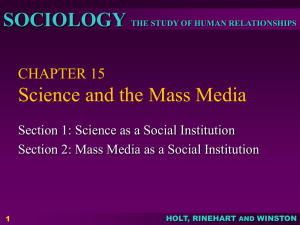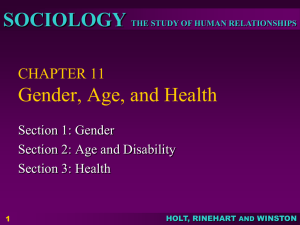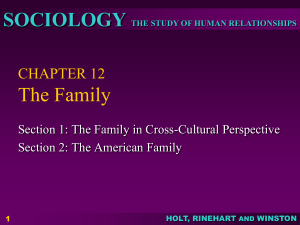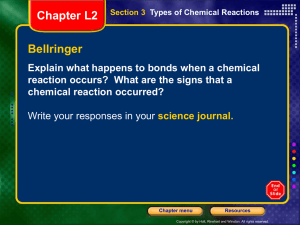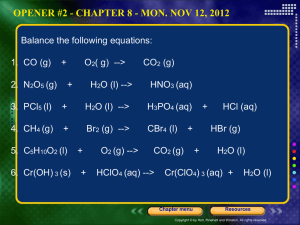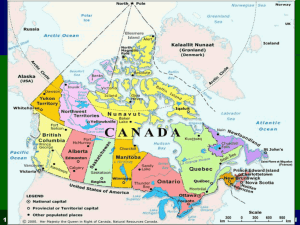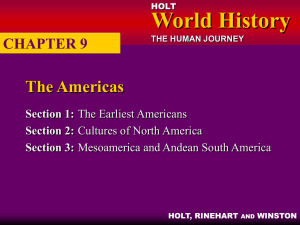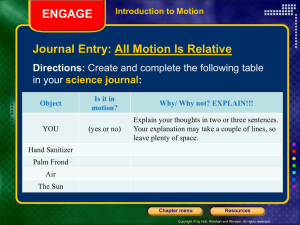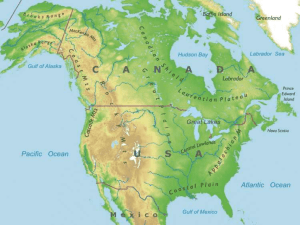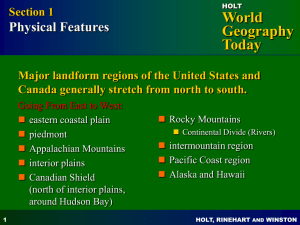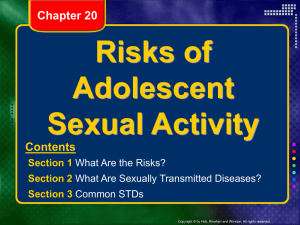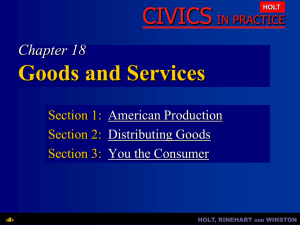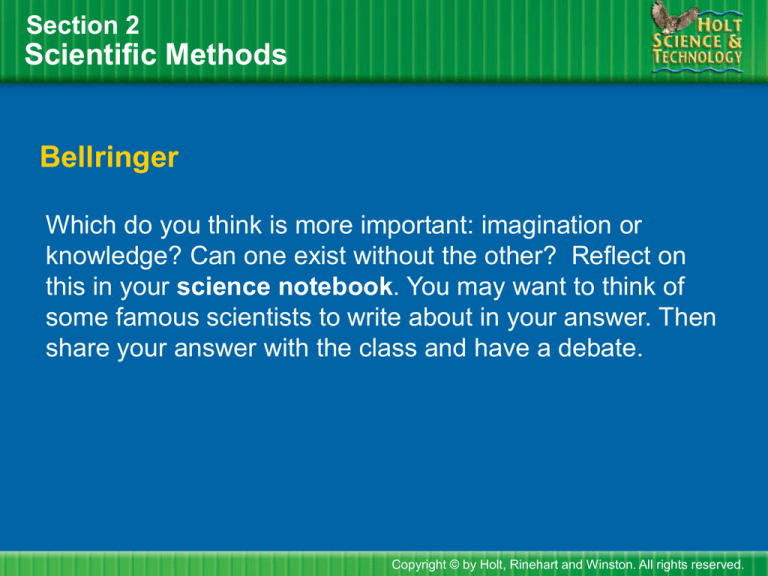
Section 2
Scientific Methods
Bellringer
Which do you think is more important: imagination or
knowledge? Can one exist without the other? Reflect on
this in your science notebook. You may want to think of
some famous scientists to write about in your answer. Then
share your answer with the class and have a debate.
Copyright © by Holt, Rinehart and Winston. All rights reserved.
Section 2
Scientific Methods
What Are Scientific Methods?
• Follow the Steps Scientific methods are the ways in
which scientists follow steps to answer questions and solve
problems. The next slide shows how scientific methods
work.
Copyright © by Holt, Rinehart and Winston. All rights reserved.
Section 2
Scientific Methods
Copyright © by Holt, Rinehart and Winston. All rights reserved.
Section 2
Scientific Methods
Ask a Question
• Make Observations Looking for answers may include
making more observations.
• Accurate Observations No matter what observations
reveal, they are useful only if they are accurately made and
recorded.
Copyright © by Holt, Rinehart and Winston. All rights reserved.
Section 2
Scientific Methods
Form a Hypothesis
• What Is a Hypothesis? A hypothesis is a possible
explanation or answer to a question.
• Is It Testable? To be useful, a hypothesis must be
testable.
• Predictions Before scientists can test a hypothesis, they
must first make predictions. A prediction is a statement of
cause and effect that can be used to set up a test for a
hypothesis.
Copyright © by Holt, Rinehart and Winston. All rights reserved.
Section 2
Scientific Methods
Test the Hypothesis
• Under Control A controlled experiment tests only one
factor at a time and consists of a control group and one or
more experimental groups.
• Designing an Experiment Designing a good experiment
requires planning. Every factor should be considered.
• Collecting Data If an experience produces the same
results again and again, scientists can be more certain
about the effect the variable has on the outcome of the
experiment.
Copyright © by Holt, Rinehart and Winston. All rights reserved.
Section 2
Scientific Methods
Analyze the Conclusions
• Organize the Data After scientists finish their tests, they
must analyze the results. Scientists must organize the data
so that they can be analyzed.
Copyright © by Holt, Rinehart and Winston. All rights reserved.
Section 2
Scientific Methods
Draw Conclusions
• After Analyzing the Data After scientists have analyzed
the data from several experiments, they can draw
conclusions.
• Is It the Answer? Finding an answer doesn’t always end
an investigation. Often, that answer begins another
investigation. In this way, scientists continue to build
knowledge.
Copyright © by Holt, Rinehart and Winston. All rights reserved.
Section 2
Scientific Methods
Communicate Results
• Organize the Data Scientists form a global community.
After scientists complete their investigations, they
communicate their results to other scientists.
Copyright © by Holt, Rinehart and Winston. All rights reserved.
Section 3
Scientific Models
Think about this. . .
Answer the following questions in your science journal:
• What is a model?
• Name several types of models.
• What models have you used in your own life?
Then share your answers in a discussion with the class.
Copyright © by Holt, Rinehart and Winston. All rights reserved.
Section 3
Scientific Models
Types of Scientific Models
• Physical Models A toy rocket and a plastic skeleton are
examples of physical models.
• Mathematical Models A mathematical model may be
made up of numbers, equations, or other forms of data.
• Conceptual Models The third type of model is the
conceptual model. Some conceptual models represent
systems of ideas. Others compare unfamiliar things with
familiar things.
Copyright © by Holt, Rinehart and Winston. All rights reserved.
Section 3
Scientific Models
Benefits of Models
• What Can Models Be Used For? Models are often used
to represent things that are very small or very large. Models
may also represent things that are very complicated or
things that no longer exist.
Copyright © by Holt, Rinehart and Winston. All rights reserved.
Section 3
Scientific Models
Building Scientific Knowledge
• Scientific Theories An explanation that ties together
many related facts, observations, and tested hypotheses is
called a theory.
• Scientific Laws In science, a law is a summary of many
experimental results and observations.
• Combining Scientific Ideas Ideas from physical and
earth science can be combined with ideas from life science.
• Scientific Change If new evidence contradicts an
accepted idea, scientists must be willing to reexamine the
evidence and reevaluate their reasoning.
Copyright © by Holt, Rinehart and Winston. All rights reserved.
Section 4
Tools, Measurement, and Safety
Bellringer
Why do you think scientists use tools such as graduated
cylinders and stopwatches? Where in your home do you
find objects that are used for precise measurement? Do
you think scientific activities ever happen in your home?
Why or why not? Record your thoughts in your science
notebook.
Copyright © by Holt, Rinehart and Winston. All rights reserved.
Section 4
Tools, Measurement, and Safety
Computers and Technology
• What Is Technology? The application of science for
practical purposes is called technology.
• Computers and Science Computers can be used to
create graphs, solve complex equations, and analyze data.
Computers also help scientists share data and ideas with
each other and publish reports about their research.
Copyright © by Holt, Rinehart and Winston. All rights reserved.
Section 4
Tools, Measurement, and Safety
Tools for Seeing
• Compound Light Microscope A compound light
microscope is an instrument that magnifies small objects so
that they can be seen easily. The next slide shows a
compound light microscope.
• Electron Microscope In electron microscopes, tiny
particles called electrons are used to produce magnified
images.
Copyright © by Holt, Rinehart and Winston. All rights reserved.
Section 4
Compound Light Microscope
Copyright © by Holt, Rinehart and Winston. All rights reserved.
Section 4
Tools, Measurement, and Safety
Measurement
• The International System of Units In the late 1700s, the
French Academy of Sciences began to form a global
measurement system now known as the International
System of Units (also called SI, or Système International
d’Unités). Today, most scientists and almost all countries
use this system.
Copyright © by Holt, Rinehart and Winston. All rights reserved.
Section 4
Tools, Measurement, and Safety
Measurement continued
• Length A meter is the basic SI unit of length.
• Volume Volume is the measure of the size of an object in
three-dimensional space. Volume is often given in liters.
• Mass A measure of the amount of matter in an object is
mass. The kilogram is the basic unit for mass.
Copyright © by Holt, Rinehart and Winston. All rights reserved.
Section 4
Tools, Measurement, and Safety
Measurement continued
•Temperature Temperature is the measure of how hot an
object is. Scientists often measure temperature in degrees
Celsius.
• Area Area is the measure of an object’s surface. The
units for area are square units, such as square meters.
• Density The ratio of the mass to volume of a substance is
density. Units often used for density are grams per milliliter.
Copyright © by Holt, Rinehart and Winston. All rights reserved.
Section 4
Common SI Units and Conversions
Copyright © by Holt, Rinehart and Winston. All rights reserved.
Section 4
Tools, Measurement, and Safety
Safety Rules!
• Safe Scientific Investigations Safety rules must be
followed at all times during a scientific investigation.
• Get Permission Before starting any scientific
investigation, obtain your teacher’s permission.
• Understand Procedures Read the lab procedures
completely and carefully before you start.
• Learn Safety Symbols Pay attention to safety
information and caution statements.
Copyright © by Holt, Rinehart and Winston. All rights reserved.
Chapter 1
The World of Life Science
Concept Map
Use the following terms to complete the concept map on
the next slide: scientific methods, observations, controlled
experiments, living things, life science, drawing
conclusions.
Copyright © by Holt, Rinehart and Winston. All rights reserved.
Chapter 1
Concept Map
Copyright © by Holt, Rinehart and Winston. All rights reserved.
Chapter 1
Concept Map
Copyright © by Holt, Rinehart and Winston. All rights reserved.

